ZIYARAH TO MASJID-NABAWI(PROPHET ‘S MOSQUE)
Millions of People dream to make a Visit to the resting Place of our Beloved Prophet-Prophet Muhammad(pbuh) for atleast Once in their lifetime.Few Makes it Possible but not Many are aware of the Secret Signs of Masjid Nabawi (Madina).I am Writing this Article with the hope that this Article will help My brothers and Sisters in Islam make the best Out of their Visit to Masjid Nabawi.
Raudah-ul-Jannah(Garden of paradise)
The Biggest attraction for Muslim of all times is the Raudah or the Riad-ul-Jannah Popularily Known as the garden of Paradise.It is a part of Masjid-e-Nabawi which is 22 meters in length and 15 meters in width, with some part of it situated inside Hurah (chamber) of Muhammad (PBUH).Abu Hurreha describes that the Holy Prophet (PBUH) said:
“Between my house and my pulpit lays a garden from the gardens of Paradise, and my pulpit is upon my fountain (Al-Kauthar).” [Bukhari]
It is identifiable by green carpets.(Raudhah-ul-jannah)
The high significance of Riadh-ul-Jannah is evident from the above Hadith that it is called a garden similar to the ones present in paradise .Subhan Allah.
Watch for the Secret Signs of Masjid Nabawi-
When you visit Prophet’s Mosque,Please make sure you locate and read Salah in these blessed points of Masjid Nabawi.Here is a video in urdu,Which gives a visual description of Raudah ul jannah.
7 Pillars of Masjid Nabawi :-
Do You Know that there are Seven Significant Pillars in Masjid Nabawi which holds a lots of historical Importance?If You have Watched the above Video you must have noticed their Position Visually.I am detailing their location in text so that next time you Visit Masjid Nabawi you can Search for them and Make a Prayer in those blessed places.And Please Remember Me too in your Duas.
1. Ustuwaanah Hannaanah
This pillar is located behind the mihrab of the Prophet ﷺ on its right hand side and is the most blessed of the pillars for this was the Prophet’s ﷺ place of prayer. On this spot there once used to grow a date palm. The Prophetﷺ used to lean on it while delivering the khutbah (sermon). When a minbar was made, the Prophet ﷺ began delivering his sermon from there. When this happened, the sound of crying was heard from the tree and it could be heard around the whole masjid. The Prophet then went to the tree, placed his hand on it and the crying stopped. He then said:
“The tree cried because the remembrance of Allah was near it, and now that the minbar is built it has been deprived of this remembrance in its immediate vicinity. If I did not place my hand on it, it would have cried till the Day of Judgement.”
The pillar which has been placed in its place is called Ustuwanah Hannanah because the word ‘hannaanah’ is used to describe a crying camel.
2. Ustuwaanah A’ishah (May Allah be pleased with her)
This is also called the Ustuwaanah Muhajireen because the Muhajireen (emigrants from Makkah to Madinah) used to sit near this spot. The Prophet ﷺ used to offer his prayers at this place before he moved to the place at Ustuwaanah Hannanah. It is also called the Ustuwaanah Qur’ah. The reason for this is that A’ishah (may Allah be pleased with her) reported that the messenger of Allah ﷺ said:
“In this Masjid is one such spot that if people knew the true blessed nature thereof, they would flock towards it in such that to pray there they would cast lots (Qur’ah).”
People asked her to point out the exact spot which she refused to do. Later on, after Abdullah Ibn Zubair (may Allah be pleased with him) persisted, she pointed to this spot. It is called Ustuwaanah A’ishah because the Hadeeth is reported by her and the exact spot was shown by her.
3. Ustuwaanah Tawbah/Abu Lubabah
During the battle of Banu Quraydhah, after the enemies had been surrounded by the Muslims, the besieged tribe called on Abu Lubabah (may Allah be pleased with him) to tell them what the Muslims were planning to do with them. Abu Lubabah had previously had dealings with the Banu Quraydhah and after seeing their crying and wailing, he told them what the Muslims were planning to do.
He wasn’t suppose to reveal anything to the enemy and realising his mistake, he became grieved and proceeded to go to the Masjid. He came to a date tree and tied himself to it saying:
“As long as my repentance is not accepted by Allah, I shall not untie myself from here. And the Prophet ﷺ himself must undo my bonds.”
When the Prophet ﷺ heard this, he said:
“If he had come to me I would have begged forgiveness on his behalf. Now he had acted on his own initiative, so how can I untie him until such a time that his repentance has been accepted.”
For many days he remained tied there without food and water, except for prayers and when he had to answer the call of nature. Then one morning, after a few days, he received the good news that his repentance (tawbah) had been accepted. The companions conveyed the news to him and wanted to untie him but he refused, saying:
“As long as the Prophet ﷺ does not untie me with his blessed hands, I shall not allow anyone else to do so.”
When the Prophet ﷺ entered for Fajr prayers, he untied him. The pillar is called Ustuwaanah Tawbah (repentance) or Abu Lubabah as it was this very spot in which Abu Lubabah tied himself seeking repentance
4. Ustuwaanah Wufood
‘Wufood’ means delegations, whenever a delegation arrived to meet the Prophet ﷺ on behalf of their tribes, they would be met at this place where he used to meet them, converse with them and teach them about Islam
5. Ustuwaanah Hars/‘Ali (may Allah be pleased with him).
Hars’ means to watch or protect. This used to be the place where some of the companions (may Allah b pleased with them) used to sit when keeping watch or acting as gatekeepers. ‘Ali (may Allah be pleased with him)used to be the one who would do this often due to which it is also known as Ustuwaanah Ali.
When the following verse was revealed, the Prophet ﷺ told his companions that he no longer needed people to keep watch as Allah had promised to protect him.
“..And Allah will protect you from the people..” Surah Al Ma’idah, Verse 67
6. Ustuwaanah Sareer
‘Sareer’ means sleeping place. It is reported that the Prophet ﷺ used to make i‘tikaaf here (seclude himself in the Masjid) and used to sleep here while in i‘tikaaf. A platform of wood used to be put here for him to sleep on.
7. Ustuwaanah Tahajjud
It is reported that this was the spot where late at night a carpet was spread for the Prophet ﷺ to perform tahajjud prayer after the people had left. There used to be a niche at this place to indicate the Prophet’s ﷺ place of performing Tahajjud but it has now been hidden with a bookcase .
These seven places are special but so is the entire Masjid and the city of Madinah. You cannot take a step except imagine that the Prophet ﷺ or his companions must have tread on that exact space many years ago.
There are also pillars which indicate the boundary of the original masjid as it was at the time of the Prophet ﷺ. Written on the top of each pillar is ‘this is the Masjid of the Prophet ﷺ’.
Original praying spot of the Prophet (s.a.w.)
This pillar, the fifth one down from the ‘Aisha’ pillar and in line with Bab-e-Jibraeel is the approximate spot where the Prophet (s.a.w.) led salah in Madinah when the Qiblah was still towards Jerusalem and at the opposite direction of Makkah.

Garden of Abu Talha (r.a.)
The highlighted area, which is in the rear of Masjid-e-Nabwi is the approximate spot where existed a garden at the time of the Prophet (s.a.w.) that was owned by Abu Talha (r.a.). The Prophet (s.a.w.) often visited this garden and drank the water from its well.
Anas (r.a.) says, ‘Abu Talha owned the best gardens in Madinah, and they were more numerous than those of any other Ansari. One of his gardens was known by the name of Bir Ha, and this was his most favourite resort. It was close to the Prophet’s Masjid and the water of its well was sweet and abundant. When Allah (swt) revealed the verse of the Holy Quran
“You will not attain unto piety until you spend of that which Ye love.” [3: 92]Abu Talha (r.a.) presented himself to the Prophet (s.a.w) and opened his heart, “O, Prophet of Allah! I love Bir Ha very much. As Allah wants us to spend precisely that which we love, I make over that garden to be spent in the path of Allah as you please.”The Prophet (s.a.w.) was very much pleased, and remarked: “What a fine present (to Allah)! I think it would be best utilized if you distribute it among your own heirs.” Abu Talha (r.a.) went and acted upon the Prophet’s advice.
Raudhah for the Women:
Unfortunately Women cannot Visit these Pillars as Most of them are loctated in the Men’s Section.Raudhah for ladies is not Open at all times.They Open for a Specific times.I have written a detailed Post about Raudhah of the ladies Section and the best time for Visiting raudhah for the Ladies which You can read here.
Keepers of the Sacred Chamber
Another Secret of Masjid Nabawi which I want to Share with you is about the Keepers of the Sacred Chamber of Masjid Nabawi .They are not Ordinary Men.They are Eunuchs from Abyssinia Known as Guardians. This group of Guardians(also known as the Aghwats), hailing from Abyssynia (a region in northern Ethiopia), hold the keys to both the Prophet Muhammad’s burial chamber and the minbar (mosque’s pulpit). At one time, their numbers rose to over one hundred strong. Today, this tradition has now shrunk to a handful of Guardians. Read the Full Story and See their Rare Photographs-Here.
Do You Know About the People Who Attempted to Steal the Body of Our Prophet
Yes It is true.Many Attempts Were Made to Steal the Body of Our Prophet(pbuh)There is Even a Story Circulating in the Social Media that there is a struck body in the Green Dome Which Absolutely is Myth.Read More about this Story Here.
Masjid Nabawi From Its First Construction to the Present Day Expansion.
With growing Muslim Population,Construction had to be carried out to Accomodate the growing sea of Pilgrims.The Story of Expansion of Prophet’s Mosque is also Very Intersting.
COURTYARD OF MASJID-NABAWI
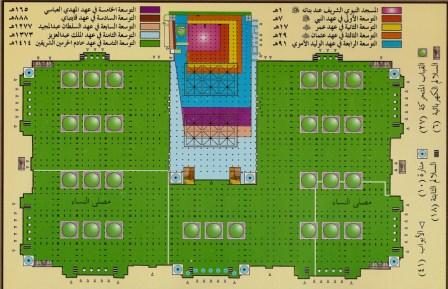
The First Masjid
The Masjid measured 35x30m. From how we see the Masjid today, the original one included the Raudhah, plus two rows of pillars on the western side and two rows on the northern side.
Dark Orange: The first expansion took place after the Battle of Khaybar due to the increase in the number of Muslims, Alhumdulillah. The foundations were made of stone and its walls from adobe bricks and the pillars from the trunks of the date-palm trees and the height of the roof was seven cubits.
Yellow: The expansion during the Caliphate of Umar bin Al-Khattab RadhiAllahu anhu, 17 AH. It was built in the same style as done by The Prophet SallAllahu alaihi wassalam, except that the stone foundations were built to the height of an average man, and the date-palm trunks were replaced with wood, adobe bricks and date-palm branches were still used.
Orange: During the time of Uthman bin’Affan RadhiAllahu anhu, 29 AH. Apart from the increase in size, the changes made during this expansion included use of carved stone and plaster for the walls and a roof of Saj, a soft wood from India which has a pleasant sweet smell. The current Mihrab is located where Uthman bin’Affan RadhiAllahu anhu used to lead the prayer from.
Blue: During the time of the Umayyad caliph, Al-Walid bin ‘Abdul-Malik, (88-91 AH), who sent the order to the then Governor of Madinah, Umar ibn ‘Abdal-Aziz to enlarge the Masjid and to incorporate into the extension the houses of the Prophet SallAllahu alaihi wassalam’s widows RadhiAllahu anhunna, who had all passed on by then. A wall was built around the house of Lady Aishah RadhiAllahu anhu, containing the three tombs. Four minarets were added to the Masjid, one at each corner.
The walls were built of carved stone and the pillars were hollowed-out stone, filled with iron and lead for supports. Two ceilings were made, an upper and a lower, the lower one being of Saj wood. The internal walls were decorated with geometric designs of marble and gold and mosaic. The gilding of the ceilings and tops of the columns and the lintels of the doors was completed, and twenty doors were opened.
Purple: During the time of Al-Mahdi, the Abbasid, 160-165 AH. The doors were increased to twenty four with the northern side expanded taking in the houses of Abdur-Rahman bin ‘Auf, which was known as Darul Mulaikah, the house of Shurahbil bin Hasanah and the remains of the house of Abdullah bin Mas’ud RadhiAllahu anhuma, which was known as Darul-Qurra.
Brown: During the time of Qaitbay 886-888 AH. When the Prophet SallAllahu alaihi wassalam’s Masjid was burnt on the night of the 13th of Ramadhan 886 AH, Sultan Qaitbay undertook the task of a complete restoration of the Masjid. He widened the eastern side, and made a single ceiling at the height of twenty-two cubits, and he rebuilt the Chamber as it is now. The current Mihrab dates from then and the first Mukabbariyyah was erected at that time. These extensions remained for three hundred and seventy years!
Salmon: During the time of Sultan ‘Abdul-Majeed 1260-1277 AH. The Ottomans quarried a red rock, resembling carnelian from mountains around Madinah to use for this phase of the extensions. The floor was covered in marble and the pillars burnished to resemble the colour of the stone. The domes were engraved with designs and patterns and the pillars in the Rouhdha were clad with white and red marble to distinguish them from the others.
Light Blue: The first Saudi extension, during the time of King ‘Abdul-’Aziz. 1370-1373 AH. This extension was distinguished by the fact that it was built in the form of a concrete edifice. Three of the five existing minarets were demolished, with two new ones erected at the eastern and western corners, the height of each being 72 meters. The number of pilgrims increased dramatically, so King Faisal in 1392 AH was responsible for the erection of large shaded enclosures made with metal roofing on the western side, but this did not affect the actual structure of the Masjid.
Green: The second Saudi extension, during the time of King Fahd bin ‘Abdul-’Aziz 1405-1414 AH. By far the largest extension increasing the surface area on all four sides, making the capacity to accommodate 650,000 worshipers. The number of minarets was increased to ten and the doors to 86, with the roof available for more pilgrims during the high seasons, and the basement used as a two leveled car park.
The Third expansion is going on…….
JajakAllah Khairan.
If you wish to share or copy this article or a Part of It,Please give due credit to this Website by adding this link{ -Via http://Islamhashtag.com}.
See Copyright Notice .
☆☆Recommended ☆☆
Discover more from Islam Hashtag
Subscribe to get the latest posts sent to your email.

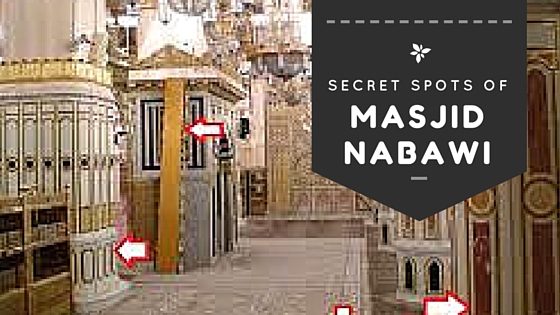
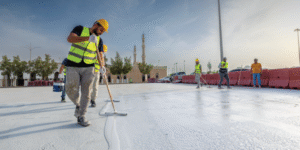



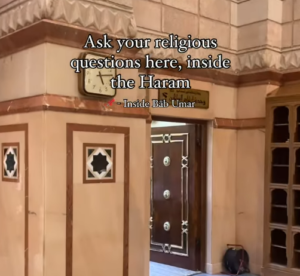
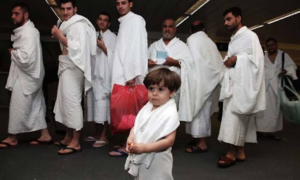

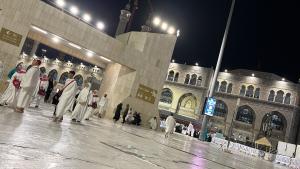
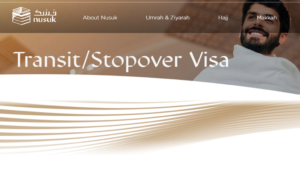
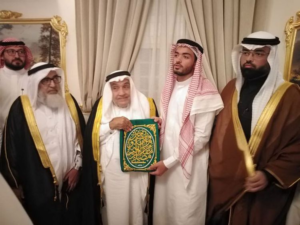
Great work Aafia.
JazakAllahu Khairan Aafia. The article is indeed very informative and useful
Wa iyyakum
jizakamullah, i really impressd, may Almighty bless you, very valuable information.